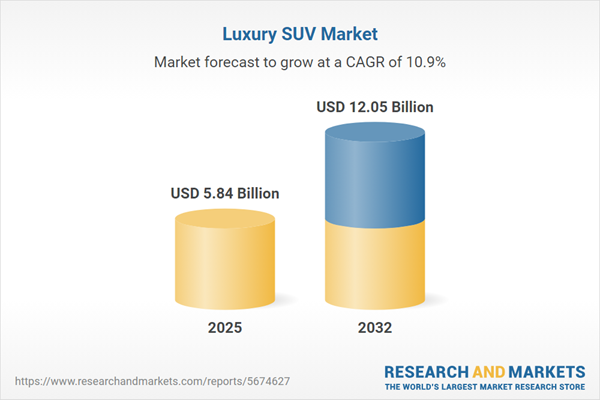Speak directly to the analyst to clarify any post sales queries you may have.
The luxury SUV market is navigating rapid transformation, driven by technological advancement, dynamic consumer preferences, and evolving regulatory pressures. Senior decision-makers prioritize actionable insight as they adapt to heightened expectations around sustainability and digital engagement while safeguarding long-term growth.
Luxury SUV Market Snapshot
In 2024, the luxury SUV market stands at USD 5.26 billion and is projected to grow to USD 5.84 billion in 2025, reaching USD 12.05 billion by 2032. This represents a compound annual growth rate (CAGR) of 10.90%. This expansion is propelled by increased adoption of advanced automotive technologies, strong momentum in electrification, and the growing presence of digitally connected luxury vehicles. Leading manufacturers are enhancing portfolios to keep pace with shifting customer preferences and changing regulatory priorities. As competition intensifies and global strategies diversify, timely industry intelligence is essential for maintaining competitive positioning within this rapidly evolving market.
Scope & Segmentation of the Luxury SUV Market
- Distribution Channels: Both traditional dealerships and digital sales platforms expand the reach of luxury SUVs, enabling manufacturers to engage customers directly, improve market penetration, and ensure global service accessibility.
- End Users: Private individuals, business fleets, and rental agencies each demand varying degrees of luxury features, operational efficiency, and robust after-sales support, shaping product strategies and service delivery models.
- Seating Capacity: Offerings range from five- to seven-seat models, appealing to executives, families, and group travelers, with flexible interiors and advanced design tailored to evolving comfort and utility requirements.
- Powertrain Types: Diesel, petrol, hybrid, and electric powertrains allow manufacturers to address emission regulations, align with sustainability goals, and accommodate varied operational and policy needs.
- Engine Displacement: Choices extend from under 2.0 liters to above 3.0 liters, enabling organizations to balance performance and efficiency in their procurement strategies.
- Price Range: Entry-level to ultra-premium models offer procurement teams diverse options to align with organizational budgets and priorities without sacrificing anticipated quality or performance.
- Regions: Market strategies must consider region-specific regulatory conditions, customer behaviors, and adoption rates across the Americas, Europe, Middle East & Africa, and Asia-Pacific.
- Key Companies: Prominent manufacturers, including Mercedes-Benz Group AG, BMW AG, Audi AG, Toyota Motor Corporation, Jaguar Land Rover Limited, Volvo Car Corporation, Porsche AG, Tesla Inc., General Motors Company, and Honda Motor Co., Ltd., set the pace for technology innovation, sustainability benchmarks, and premium customer experiences.
Key Takeaways for Senior Decision-Makers
- Flexible vehicle architectures and rapid integration of digital solutions help manufacturers respond quickly to evolving customer demands and feature preferences.
- After-sales service enhancements, including advanced predictive maintenance and integrated safety systems, foster long-term client engagement and brand loyalty in core market segments.
- Electrification trends are reshaping workforce skill requirements and supply chain approaches, supporting sustainability goals and operational resilience in the luxury SUV sector.
- Omni-channel experiences that seamlessly connect physical dealerships with online engagement boost customer involvement through research, acquisition, and after-purchase phases.
- Adopting regionally tailored strategies allows organizations to respond to distinct local conditions, navigate regulatory mandates, and leverage varying rates of technology adoption for stable growth.
Impact of United States Tariff Policies on Market Dynamics
Anticipated United States tariff policy modifications for 2025 are compelling luxury SUV manufacturers to adjust production strategies and realign sourcing and pricing frameworks. Industry players are strengthening domestic investments, optimizing supplier networks, and developing adaptive pricing to counteract uncertainty. Responsive inventory management and agile marketing approaches are essential to sustain operations and reduce the impact of shifting policy environments.
Methodology & Data Sources
This luxury SUV market report is built on comprehensive expert interviews, detailed industry feedback, and a methodical review of both regulatory and proprietary datasets. Advanced scenario analysis and rigorous data triangulation underpin the reliability and actionable quality of all research findings.
Why This Luxury SUV Market Report Matters
- Delivers actionable intelligence to support strategic planning amid complex regulatory and competitive shifts in the luxury SUV segment.
- Enables senior leaders to identify promising regional opportunities and manage evolving risks, improving both investment strategy and day-to-day operations.
- Supports executive decision-making on resource allocation, supply chain optimization, and progress on sustainability priorities.
Conclusion
The luxury SUV market continues to evolve with accelerating technology, shifting consumer needs, and regulatory adjustments. Access to authoritative, current market data empowers senior leaders to identify top opportunities and shape robust, forward-thinking strategies.
Additional Product Information:
- Purchase of this report includes 1 year online access with quarterly updates.
- This report can be updated on request. Please contact our Customer Experience team using the Ask a Question widget on our website.
Table of Contents
3. Executive Summary
4. Market Overview
7. Cumulative Impact of Artificial Intelligence 2025
Companies Mentioned
The companies profiled in this Luxury SUV market report include:- Mercedes-Benz Group AG
- Bayerische Motoren Werke Aktiengesellschaft
- Audi AG
- Toyota Motor Corporation
- Jaguar Land Rover Limited
- Volvo Car Corporation
- Porsche AG
- Tesla, Inc.
- General Motors Company
- Honda Motor Co., Ltd
Table Information
| Report Attribute | Details |
|---|---|
| No. of Pages | 184 |
| Published | October 2025 |
| Forecast Period | 2025 - 2032 |
| Estimated Market Value ( USD | $ 5.84 Billion |
| Forecasted Market Value ( USD | $ 12.05 Billion |
| Compound Annual Growth Rate | 10.9% |
| Regions Covered | Global |
| No. of Companies Mentioned | 11 |









